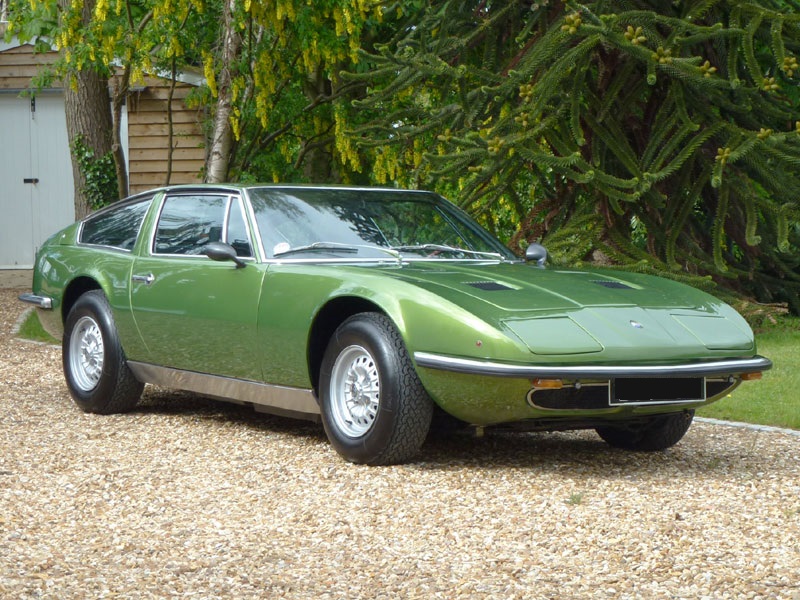-
Insurance
InsuranceAbout our productsLearn about insuringGet a quote Get current values, historical values, model history and more.
-
Valuation
ValuationHagerty valuation toolLook up a vehicle value Get current values, historical values, model history and more.
-
Events
EventsHagerty official eventsHagerty ClubhouseEvent calendar
-
Entertainment
EntertainmentMore to explore
- Portal login
1971 Maserati Indy
4.2 Coupe 4.1 L
Vehicle values by condition
Fair
Condition 4
£29,900
#4 cars are daily drivers, with flaws visible to the naked eye. The chrome might have pitting or scratches, the windshield might be chipped.
Good
Condition 3
£39,800
#3 cars could possess some, but not all of the issues of a #4 car, but they will be balanced by other factors such as a fresh paint job or a new, correct interior.
Excellent
Condition 2
£49,800
#2 cars could win a local or regional show. They can be former #1 cars that have been driven or have aged. Seasoned observers will have to look closely for flaws.
Concours
Condition 1
£59,600
#1 vehicles are the best in the world. The visual image is of the best car, unmodified, in the right colours, driving onto the lawn at the finest concours.
Insurance premium for a
1971 Maserati Indy 4.2 Coupe 4136
valued at £39,800
£233.51
/ year*
History of the 1969 - 1973 Maserati Indy

1969 - 1973 Maserati Indy
There was a sense among exclusive sports car manufacturers in the late 1960s that the world needed a 2+2 supercar. Lamborghini built the Espada, Ferrari built the 365 GT 2+2 'Queen Mary', Iso had its Lele, and Maserati’s entry was the Indy. The idea was to give the Grand Touring models a little extra style and space.
Designed by Vignale, the Maserati Indy was based on the Maserati Quattroporte chassis and succeeded the conservative (and much smaller) Sebring. Initially offered with the 260bhp, 4,136cc Quattroporte V-8, later models received the 290bhp 4.7-litre V-8 in 1970, and 335bhp 4.9-litre engine in 1973. A 5-speed ZF gearbox was standard, with a 3-speed Borg-Warner automatic optional. Electric windows were standard.
The Indy resembled the 2-seater Ghibli at the front, with pop-up headlights and wrap-around bumper, but the roofline was pushed up five inches and extended for rear headroom, which compromised the design. There was an opening rear hatch and the body was welded to the chassis, instead of bolted, as in previous models. A total of 1,136 Indys were built, at the rate of four or five a week, and among the last was a special US market Indy America model.
A large number of 2+2 supercars were sold but they have failed to find much support among collectors, and prices have languished. As always in these cases, the check you write to buy one is only the first, if repair work is needed. Rust is a big concern and detailed provenance must include where the cars were located, as well as complete bills for service and repair work. With so many built, the Indy is one of the cheapest ways into a supercar. Just don’t expect prices to rise much anytime soon.
Interestingly, when Alejandro de Tomaso took over Maserati in 1976, (after its brief romance with Citroen) he cancelled the Indy and re-engineered his Ford-powered DeTomaso Longchamps 2+2 to accept a Maserati 4.2-litre V-8. The new car was called the Kyalami. The nose was restyled by Ghia, and later examples were fitted with the 335bhp 4.9-litre V-8. But nobody was fooled by such badge engineering, and the Kyalami sold only 150 examples between 1977-1983. Unaccountably, the DeTomaso Longchamps lingered until 1990.
All 1971 Maserati Indy body types
| Year | Make | Model | Submodel | Body Type | Engine size | Average value |
|---|---|---|---|---|---|---|
| 1969 | Maserati | Indy | 4.2 | Coupe | 4.1 L | £ 29,900 39,800 49,800 59,600 |
| 1970 | Maserati | Indy | 4.7 | Coupe | 4.7 L | £ 39,000 47,400 57,500 69,000 |
Hagerty Newsletter
Get your weekly dose of car news from Hagerty UK in your inbox

ADVERTISEMENT